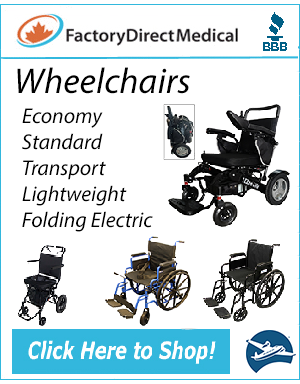Wheelchair Features and Components
Wheelchairs have many options to make the equipment more functional for the end user. Below I've listed the more common options and a short description of each.
Wheelchair Anti-Tippers
Anti-Tippers are devices which are attached to the back of the wheelchair to prevent it from tipping over backward. Anti-tippers are standard on tilting and reclining wheelchairs but optional on other styles of chairs. This option is commonly prescribed for users who rock in their wheelchair, tend to flop into the chair when transferring, or have difficulty climbing ramps and slops. Anti-tippers are also prescribed for kids to prevent the accidental tipping by playmates. Anti-tippers can be removed in situations where the wheelchair might get hung up such as negotiating a curb but removal must be done by someone besides the user.
Quick Release Wheelchair Axles
Quick Release Axles are options for the rear wheels which are standard on all rigid frame wheelchairs. These axles have a button in the center which when pushed, allow for the easy removal of the wheels. There is a version referred to as a quad release which incorporates a lever rather than a button and is designed for people who don't have the dexterity to push a button. This option is of value to those who own a smaller car and have trouble fitting a wheelchair into it and for those who want to reduce of the chair when loading it into a vehicle.
Adjustable Wheelchair Axle Plates
Adjustable Axle Plates are standard on the more performance oriented wheelchair models but can be purchased on many of the midrange chairs. Adjustable axle plates allow for the repositioning of the rear wheels vertically and horizontally. This option is invaluable when setting up a wheelchair as it enables adjustment of seat height, seat dump and center of gravity.
Adjustable Wheelchair IV Poles
Adjustable IV Poles can be added to any wheelchair by mounting to the back canes. This is an especially important device if the wheelchair user is tube fed or requires frequent IVs. There are a few after market versions but I've had more success with a pole I designed and manufactured myself. Your vendor should be able to rig up something if there is no after market product for your wheelchair.
Wheelchair Cane/Crutch Holders
Cane/Crutch Holders are great for people who can walk a little but need some place to put their cane or crutches when they get into their wheelchair. The holders are mounted on the back of the wheelchair.
Wheelchair Oxygen Tank Holders
Oxygen Tank Holders are also available, but it's usually easier to get them from your oxygen supplier than your wheelchair supplier if they're not the same vendor. If forced to get one from you wheelchair supplier, make sure they know the type of tank you use and the manufacturer of the oxygen system. There are various types, shapes and sizes of tanks and getting the right one can be a challenge.
Wheelchair Pouches
Wheelchair Pouches are available from after market companies and come in various sizes and shapes. It's quite difficult to carry objects and propel a wheelchair at the same time and pouches can make life easier. The larger ones which mount on the back posts of the wheelchair can carry a fair amount but may throw the balance of the chair off. The smaller ones capable of only carrying keys or a wallet or something similar can be mounted on the arms or under the front of the seat.
Wheelchair Stroller Handles
Stroller Handles are extensions for caregiver push handles which are standard on most tilt frame wheelchairs so the person pushing the chair doesn't have to bend over while pushing. They are also available for kids chairs which tend to be fairly low to the ground. An added benefit of stroller handles is that the person pushing the chair pushes from further back which reduces the number of times the caregiver kicks the back of the chair while walking.



 Online Vendors
Online Vendors  US Online Vendors
US Online Vendors 

